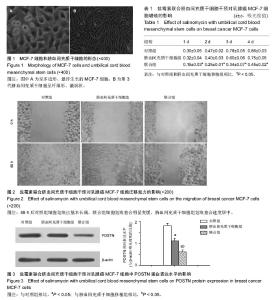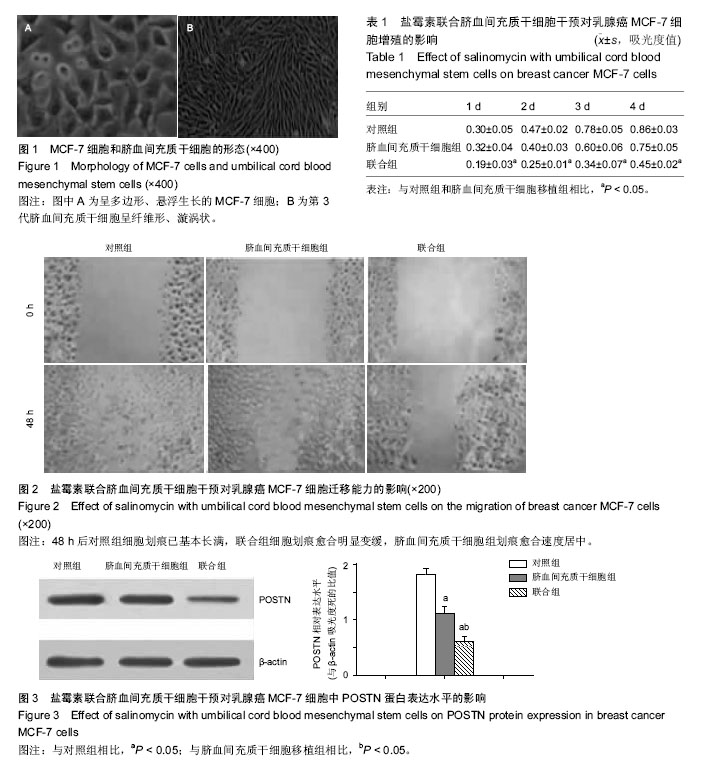| [1] 尹宏达,谢振斌.盐霉素对乳腺癌干细胞作用的研究[J].世界最新医学信息文摘(连续型电子期刊),2015(26): 142-143.[2] 赵月,沈娜,郭辉,等.盐霉素对乳腺癌细胞抑制的作用[J].中华实验外科杂志,2013,30(6):1311-1312.[3] 孙秀梅,高峰,刘子凤.盐霉素对结肠癌干细胞特性的抑制作用[J].山东大学学报(医学版),2013,51(9):40-44. [4] Lu Y, Ma W, Mao J, et al. Salinomycin exerts anticancer effects on human breast carcinoma MCF-7 cancer stem cells via modulation of Hedgehog signaling. Chem Biol Interact. 2015;228:100-107.[5] 庞一琳,汤永永,李倩,等.人脐带间充质干细胞对血液恶性肿瘤细胞增殖的影响[J].细胞与分子免疫学杂志,2013, 29(7):714-718,722.[6] 张祖雯,魏晓丽,赵菊梅.盐霉素抗肿瘤干细胞的研究进展[J].延安大学学报(医学科学版) 2015,13(1):63-65.[7] 吴昊,马凤霞,李建平,等.人脐带间充质干细胞增强全反式维甲酸对HL-60细胞的诱导分化作用[J].中国实验血液学杂志,2010,18(4):877-881.[8] 姜丹丹,柳晓义,姜丹丹,等.IL-18基因修饰人脐带间充质干细胞对乳腺癌细胞系增殖的影响[J].中华医学杂志, 2014,94(26):2013-2017.[9] 韩丽鑫,韩之波,耿洁,等.脐带间充质干细胞对乳腺癌细胞系MCF-7裸鼠移植瘤生长的影响[J].中国组织工程研究, 2015,19(19):2986-2992.[10] 房敬超,张晓龙,张晴,等.人脐带组织间充质干细胞对小鼠肿瘤的趋化作用[J].山东医药,2015,(21):1-3,9.[11] 刘艳,张霄蓓,刘鹏,等.乳腺癌干细胞对mTOR抑制剂的药物敏感性观察[J].中华医学杂志,2015,95(24):1910- 1914.[12] Lu W, Li Y. Salinomycin suppresses LRP6 expression and inhibits both Wnt/β-catenin and mTORC1 signaling in breast and prostate cancer cells. J Cell Biochem. 2014;115(10):1799-1807. [13] 石俊杰,王哲,李阳,等.盐霉素对人肺腺癌A549细胞株生物学特性的影响[J].中华实验外科杂志,2013,30(8): 1592-1594.[14] Chao KC, Yang HT, Chen MW. Human umbilical cord mesenchymal stem cells suppress breast cancer tumourigenesis through direct cell-cell contact and internalization. J Cell Mol Med. 2012;16(8):1803- 1815.[15] 卢颖,张春影,李青,等.盐霉素通过Hedgehog信号通路抑制乳腺癌细胞MDA-MB-231的增殖[J].中华病理学杂志, 2015(6):395-398.[16] 郭雪红.盐霉素的抗癌作用研究新进展[J].国外医药(抗生素分册),2015,36(4):150-153,166.[17] Kopp F, Hermawan A, Oak PS, et al. Salinomycin treatment reduces metastatic tumor burden by hampering cancer cell migration. Mol Cancer. 2014; 13:16.[18] 孙苏园,柳晓义,姜丹丹,等. IL-18基因修饰人脐带间充质干细胞对乳腺癌细胞系增殖的影响[J].中华医学杂志, 2014,94(26):2013-2017.[19] Doi C, Maurya DK, Pyle MM, et al. Cytotherapy with naive rat umbilical cord matrix stem cells significantly attenuates growth of murine pancreatic cancer cells and increases survival in syngeneic mice. Cytotherapy. 2010;12(3):408-417.[20] Gupta PB, Onder TT, Jiang G, et al. Identification of selective inhibitors of cancer stem cells by high-throughput screening. Cell. 2009;138(4):645-659.[21] Huang X, Borgström B, Månsson L, et al. Semisynthesis of SY-1 for investigation of breast cancer stem cell selectivity of C-ring-modified salinomycin analogues. ACS Chem Biol. 2014;9(7):1587-1594.[22] Fuchs D, Daniel V, Sadeghi M, et al. Salinomycin overcomes ABC transporter-mediated multidrug and apoptosis resistance in human leukemia stem cell-like KG-1a cells. Biochem Biophys Res Commun. 2010; 394(4):1098-1104. [23] 于晓军.阿霉素对乳腺癌干细胞的体外作用研究[J].中国医药指南,2015(2):57-58.[24] 孟琳,王天一,李晓曦,等.miR-206/miR-1对乳腺癌干细胞增殖的影响及作用机制[J].中国医科大学学报,2015(5): 394-399[25] 李玉坤,王华,姜纯国,等.脐带间充质干细胞对博来霉素诱导小鼠肺纤维化的干预机制初探[J].中华结核和呼吸杂志,2013,36(11):808-813.[26] 李宗祥,孙平.蒽贝素联合阿霉素对乳腺癌细胞MCF-7增殖和荷瘤裸鼠肿瘤生长的影响[J].中国生化药物杂志, 2014(4):5-7,11.[27] Stankiewicz-Kranc A, Miltyk W, Skrzydlewska E. Comparison of influence of carmustine and new proline analog of nitrosourea on antioxidant system in breast carcinoma cells (MCF-7). Drug Chem Toxicol. 2010; 33(1):55-63. [28] 林峰,佟鑫,陈志杭.水飞蓟宾体外抑制MCF-7细胞的增殖和TGF-β诱导的侵袭转移[J].中国现代医生,2015,53(17): 1-3,7.[29] Mitkin NA, Hook CD, Schwartz AM, et al. p53- dependent expression of CXCR5 chemokine receptor in MCF-7 breast cancer cells. Sci Rep. 2015;5:9330. [30] Niu D, Wang G, Wang X. Up-regulation of cyclin E in breast cancer via estrogen receptor pathway. Int J Clin Exp Med. 2015;8(1):910-915.[31] 徐霜清,祝爱珍,刘成成,等.盐霉素抑制耐格列卫的人慢性粒细胞白血病细胞株K562/Glv增殖并诱导其凋亡[J].中国病理生理杂志,2012,28(7):1208-1212.[32] Han WD, Mu YM, Lu XC, et al. Up-regulation of LRP16 mRNA by 17beta-estradiol through activation of estrogen receptor alpha (ERalpha), but not ERbeta, and promotion of human breast cancer MCF-7 cell proliferation: a preliminary report. Endocr Relat Cancer. 2003;10(2):217-224. [33] Buteau-Lozano H, Ancelin M, Lardeux B, et al. Transcriptional regulation of vascular endothelial growth factor by estradiol and tamoxifen in breast cancer cells: a complex interplay between estrogen receptors alpha and beta. Cancer Res. 2002;62(17): 4977-4984. [34] Li Y, Chen Y, Zhu ZX, et al. 4-Hydroxytamoxifen- stimulated processing of cyclin E is mediated via G protein-coupled receptor 30 (GPR30) and accompanied by enhanced migration in MCF-7 breast cancer cells. Toxicology. 2013;309:61-65.[35] Sasaki H, Lo KM, Chen LB, et al. Expression of Periostin, homologous with an insect cell adhesion molecule, as a prognostic marker in non-small cell lung cancers. Jpn J Cancer Res. 2001;92(8):869-873. [36] Lambert AW, Wong CK, Ozturk S, et al. Tumor Cell-Derived Periostin Regulates Cytokines That Maintain Breast Cancer Stem Cells. Mol Cancer Res. 2016;14(1):103-113. [37] Park SY, Piao Y, Jeong KJ, et al. Periostin (POSTN) regulates tumor resistance to antiangiogenic therapy in glioma models. Mol Cancer Ther. 2016. in press. [38] Zhou W, Ke SQ, Huang Z, et al. Periostin secreted by glioblastoma stem cells recruits M2 tumour-associated macrophages and promotes malignant growth. Nat Cell Biol. 2015;17(2):170-182. [39] Tian B, Zhang Y, Zhang J. Periostin is a new potential prognostic biomarker for glioma. Tumour Biol. 2014; 35(6):5877-5883. [40] Wang X, Liu J, Wang Z, et al. Periostin contributes to the acquisition of multipotent stem cell-like properties in human mammary epithelial cells and breast cancer cells. PLoS One. 2013;8(8):e72962.[41] Malanchi I, Santamaria-Martínez A, Susanto E, et al. Interactions between cancer stem cells and their niche govern metastatic colonization. Nature. 2011; 481(7379): 85-89. |

